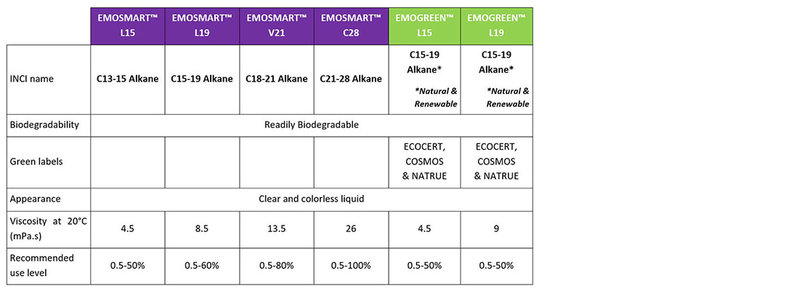The cosmetic market is in a continual search for more innovative, functional, and environmentally friendly ingredients. As such, EMOSMART™ and EMOGREEN™ have been awarded on several occasions by the industry. These two ranges of emollients, readily biodegradable and endowed with sensory attractiveness, respond to the consumers’ demand.
- January 1, 2018
- 6 minutes of read time
What if you could replace silicones....
Readily biodegradable and high purity alkanes
These two ranges of emollients are inert oils, readily biodegradable and fluid. The patented production process allows for high purity products. These neutral alkanes (inert and non-polar) are compatible with extreme formulation conditions. They’re not sensitive to oxidation, pH change or oxidizing/reducing media.
EMOGREEN™ range is based on a vegetable and sustainable biomass (the non GMO initial raw material is traceable to plantations and covered by a Mass Balance certificate according to RSPO). These emollients are COSMOS approved and NATRUE certified.
Table below details the main characteristics of the six different grades composing these two ranges.

One step closer to sustainable and responsible cosmetics
These two ranges of emollients have a very low impact on the environment. One of the main benefits of the range is they are readily biodegradable and present a negligible carbon footprint in comparison with silicone oils (EMOSMART™ reduces the carbon footprint by 85%, while EMOGREEN™ goes further with a 115% reduction).
An infinite spreading
EMOSMART™ and EMOGREEN™ ranges, as texturizing agents, play an important part in the touch of cosmetic formulations, having different sensory assets depending on the grades.
EMOSMART™ L15 presents a fresh sensory and a “nude skin” sensation after feel, EMOSMART™ C28 distinguishes itself by its extra-comfortable and nourishing finish. EMOGREEN™ is characterized by its longer playtime associated with a powdery after feel. Both these two grades are perfect candidates to replace volatile silicone oils.
Metrological measurements define the key attributes of the EMOSMART™ and EMOGREEN™ sensorial experience. Their perfect affinity with the skin provides a spontaneous spreading (contact angle measurement by goniometry). These ranges provide a uniform gliding effect all along the application, regardless of spreading velocity (friction coefficient measurement at different speeds).
In addition to improving the spreading of cosmetic galenics, these ranges reduce the sticky effect during the application. After a rheometer study, EMOSMART™ L19 and EMOGREEN™ L15 showed a significant decrease of the perceived sticky effect of a formula containing 10% glycerin; The formula containing EMOSMART™ L19 reduces the tackiness of 75% when compared to Isohexadecane.

Mattifying Effect
These ranges reveal mattifying properties (reflectometer measurement). While all the oils present an immediate glossiness; EMOSMART™ L19 and EMOGREEN™ L15 show a quick matte effect (after one minute). EMOGREEN™ L19 shows a similar profile to volatile silicone oils, as it gives a progressive matte finish to the skin.
EMOSMART™ C28 allows to obtain a non matte effect, slightly shiny that matches with the Korean trends called “dewy”, for a “morning dew” complexion, glossy and luminous but non greasy.

Let the story of senses begin…
Like a fragrance, a cosmetic galenic needs three types of oils to reveal its sensorial effects all along the texture application: the head, heart and base oils. The head oils, more evanescent, are first felt at the beginning of the application. Then, they allow the heart oil to be felt, giving its spreading and gliding properties to the texture. They prolong the head oils freshness and announce the base oils. These molecules, more heavy, appear at the end of the application and give the texture its personality and after feel.
The two light EMOSMART™ (L15 and L19) are evanescent, and have a shorter playtime and play the role of the head oils. EMOSMART™ V21, as EMOGREEN™ L15, confers an infinite gliding to the texture, characteristic of the heart oils. EMOGREEN™ L19 and EMOSMART™ C28 are defined by their touch, respectively powdery and nourishing, felt at the end of the application.

Sensoriality has become more and more sought after by the consumers in the purchasing process of a cosmetic product. EMOGREEN™ sensory profile has been compared to that of volatile silicone oil during the different steps of the sensory evaluation thanks to the PIVOT© method.
The PIVOT© analysis is a new holistic method allowing to evaluate the influence of an ingredient on a cosmetic product's sensoriality and texture.
This method has been developed in 2007 by Bertrand Thuillier for Champagnes. The PIVOT© analysis is based on a comparison between a reference formula, called “Pivot” and other formulas that differ by one ingredient. The evaluation is based on a comparison (the Pivot versus the tested formula). The trained panelists describe the texture under evaluation using the words “more” and “less” to quantify the perceived sensorial benefit.
Using this method, it has been shown that, compared to volatile silicone oils, EMOGREEN™ are preferred for the brighter appearance they bring to the formula while in the jar (a feature of a premium product). They are also acclaimed for the feeling of emolliency felt during application (more comfort during spreading) and their finish on the skin, which is equivalent to that of the volatile silicones: a matte aspect of the skin accompanied by a powdery sensation.
Emollients for all types of applications!
Thanks to their chemical nature, these two ranges are versatile oils for cosmetic products formulation.
Easy-to-formulate, these fluid and clear emollients are compatible with all types of oily phases (vegetable oils, esters, silicone oils, mineral oils…) and all cosmetic applications (skin care, hair care, sun care, make-up, deodorant, make-up removal, hair color, depilatories…).
The oils have been evaluated to be non comedogenic, so they match with every skin types. A number of specifics highlight some of the possible applications. For example, thanks to its water resistance ability, EMOSMART™ range is ideal for make-up, sun care and humid climate products.
In make-up, the substitution of a part of Polyisobutene in a gloss formula by EMOSMART™ C28 allows to decrease significantly the sticky effect of the formula, giving an extra-comfortable sensory, and also the stringy effect for an easier packaging process.
The two ranges stand out for their ability to disperse pigments and to stabilize the color of the dispersions over time, regardless of the coating type of the tested pigments.
The EMOGREEN™ range gives better results in term of make-up removal than the market reference of silicone or Isododecane.
In hair care application, EMOSMART™ L15 and V21 have shown the same capacity as silicone oil to ease hair combing (measurement of the necessary strength used to comb the hair).
Conclusion
EMOSMART™ and EMOGREEN™ are two ranges of environmentally friendly (perfect biodegradability) and easy-to-use emollients; they can be used in all kind of applications thanks to their versatility. Their sensory profile covers a broad sensory palette, allowing an infinity of textures. They are also part of the trend of cosmetic oils that encourage consumers to look for elaborated and sensual textures.

